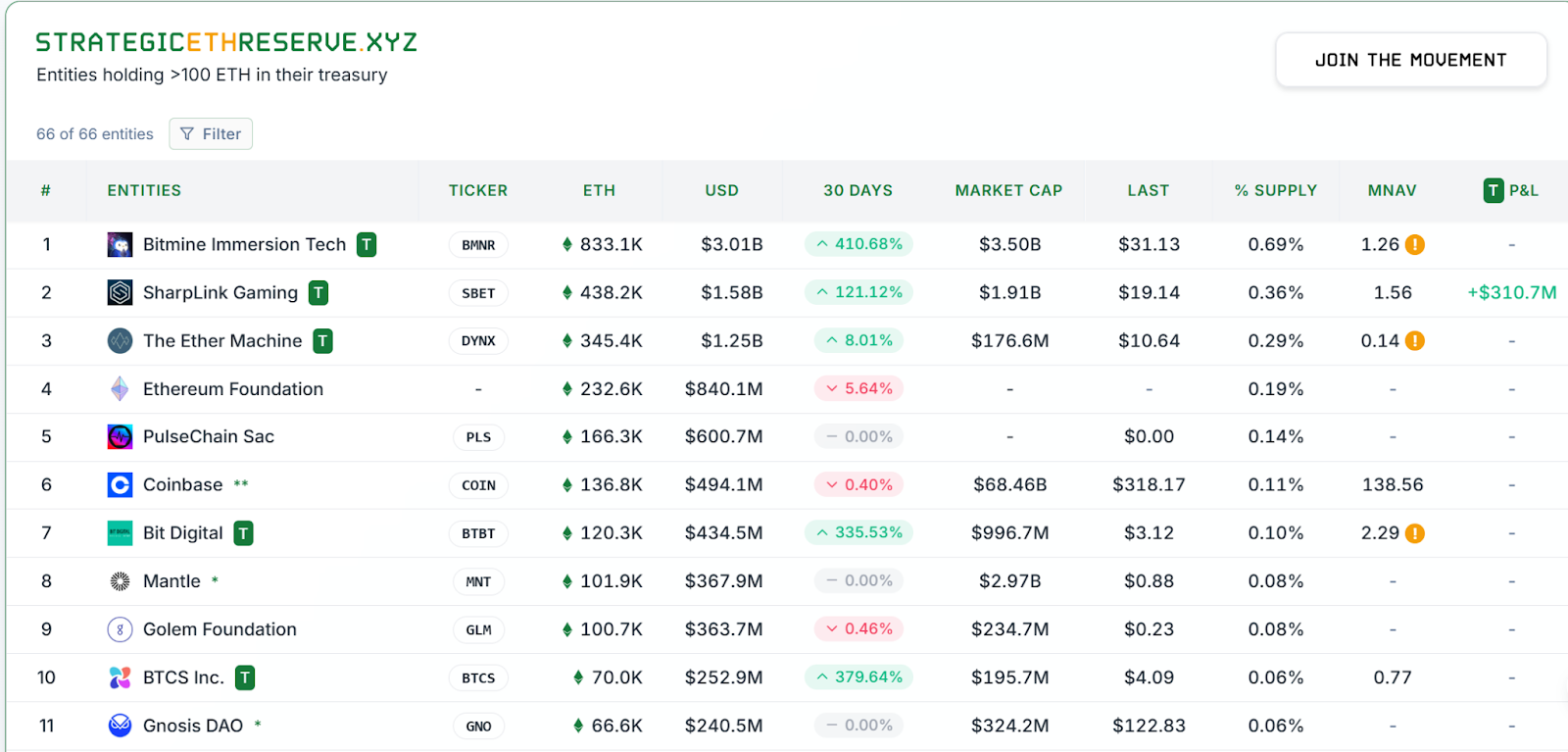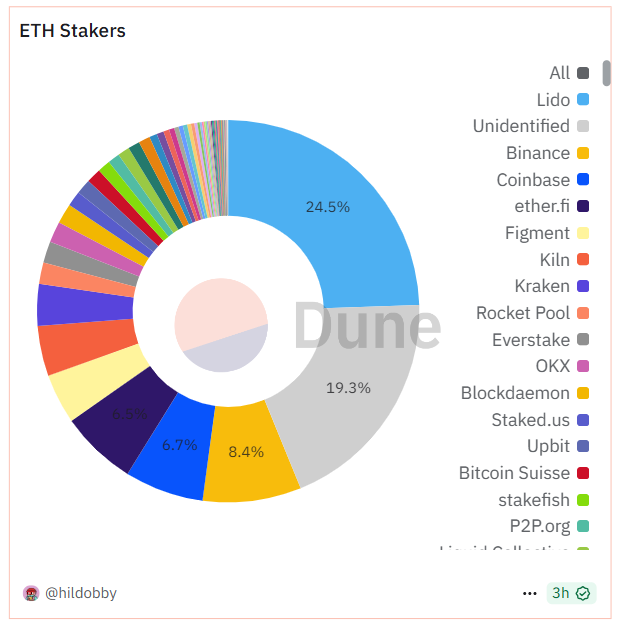Original | Odaily Planet Daily ( @OdailyChina )
Author | Dingdang ( @XiaMiPP )

From SharpLink Gaming to BitMine, the ETH treasury strategies of publicly listed companies have driven a new growth narrative for ETH, pushing the price of ETH from a peak of $2,100 to $3,940, an increase of over 87%. A new trend is emerging: the focus of corporate treasury strategies is quietly shifting from "holding" to "staking ." This will reshape people's perception of the "activity" of crypto assets: ETH will no longer be seen as a static reserve, but as a productive asset with sustainable output.
SharpLink Gaming is a pioneer in this trend. Since launching its ETH treasury strategy on June 2nd, the company has staked all of its approximately 438,190 ETH. To date, it has accumulated approximately 722 ETH in staking rewards, valued at approximately $2.6 million.
According to on-chain analyst Ember, a suspected ETH reserve address has accumulated 41,452 ETH (approximately $148 million) since August 1st, at an average price of approximately $3,575, all of which has been staked through Proof-of-Stake (PoS) using Figment. On August 3rd, it staked an additional 15,846 ETH (approximately $55.34 million). This activity is similar to that of SharpLinkGaming, and is suspected to be its reserve address, but the specific ownership of this address is currently unknown.
This strategy not only demonstrates the company's confidence in the long-term value of ETH, but also gradually transforms ETH from a price speculation asset into an enterprise-level, institutionalized "cash flow tool."
Who is the king of the treasury? Three giants compete for the top spot in ETH reserves
According to StrategicETHReserve data, three listed companies currently hold more ETH than the Ethereum Foundation.

BitMine: Financial strength trumps everything
With a holding of 833,000 ETH (approximately $3.06 billion), it holds the top spot. Bitmine, formerly a Bitcoin mining company, announced the launch of its Bitcoin reserve strategy on June 9, 2025, using proceeds from an $18 million common stock offering to purchase 154,167 Bitcoins.
However, on June 30, the company raised $250 million through private placement and announced the launch of its ETH treasury strategy, marking its official shift from BTC to ETH.
The company's shareholder lineup is equally eye-catching. PayPal co-founder Peter Thiel holds a 9.1% stake, while Ark Investment, owned by Cathie Wood, has invested a total of $182 million in BitMine shares across three funds. BitMine has publicly stated that the funds will primarily be used to purchase ETH.
Although its current average construction cost is US$3,755 and is still in a floating loss state, BitMine has established its position as the world's largest ETH treasury and the world's third largest cryptocurrency treasury.
SharpLink Gaming: Full-position Staking Takes the Lead in Compound Interest
SharpLink, which ranks second with 498,884 ETH (approximately $1.8 billion; StrategicETHReserve data is slightly delayed and subject to SEC filings), is the first publicly listed company to publicly announce the inclusion of ETH in its reserve assets. In June, the company submitted a plan to the SEC to raise $1 billion through a stock offering to purchase ETH. Compared to BitMine, SharpLink not only boasts a significant holding, but also utilizes a "full-collateralization" strategy to improve asset utilization efficiency, placing it at the forefront of ETH financial applications.
The Ether Machine: Latecomers Strive to Catch Up
With 345,000 ETH (approximately $1.26 billion), it ranks third, surpassing the Ethereum Foundation. On July 21st, the company officially launched its ETH reserve program, aiming to exceed $1.5 billion in holdings. Despite its late start, its rapid progress has made it a key variable in this round of "treasury race."
The three companies each have their own strategies: BitMine takes advantage of its financial strength to get ahead, SharpLink relies on staking to generate returns, and The Ether Machine is catching up rapidly.
ETH Treasury ≠ BTC Treasury: Structural Differences Lead to New Financial Models
The difference between the ETH treasury and the Bitcoin (BTC) treasury stems from their distinct asset properties. Bitcoin's reserve logic primarily relies on price appreciation, exemplifying a typical "passive holding" model . ETH, on the other hand, offers inherent income mechanisms such as staking, re-staking, and lending, providing a sustainable cash flow and introducing compound interest into financial models.
According to estimates by Wall Street brokerage firm Bernstein, a $1 billion ETH reserve could generate approximately $30-50 million in annual returns through staking, representing an annualized return of 3-5%. SharpLink's full-position staking strategy exemplifies this logic, achieving exponential asset growth through the continuous reinvestment of staking rewards.
In contrast, the BTC Treasury relies more on market sentiment and the "digital gold" narrative, lacking a stable native return structure. Bitwise Chief Investment Officer Matt Hougan noted that the ETH Treasury, through its "stock shell," transforms staking returns into a model similar to corporate dividends, breaking the ambiguity of Ethereum's value narrative. He stated, "The ETH Treasury's immediate, quantifiable returns from staking $1 billion in ETH are highly attractive to institutional investors."
Regulatory winds turn warmer: Pledged ETFs are on the way
Not only businesses, but even traditional finance has begun to pave the way for the possibility of ETH staking.
In early August, the US SEC announced it was reviewing a rule change application from BlackRock to allow its iShares Ethereum Trust to incorporate Ethereum staking. This application, submitted by Nasdaq, is similar to proposals from institutions like 21 Shares and Grayscale.
Once approved, the ETF will be able to stake ETH holdings and return block rewards and transaction fees to fund investors, effectively creating "ETF dividends." This not only lowers the technical barrier for institutions to enter ETH staking (no longer requiring them to operate their own validating nodes), but also introduces a more robust source of funding to the PoS ecosystem. For traditional investors, this offers a new way to participate, mitigating operational risk while still offering an annualized return of 3%-5%. However, ETH staking requires caution regarding the risk of slashing, where a validator failure could result in the loss of even small amounts of principal.
Changes in regulatory attitudes are providing compliance protection for the ETH treasury model.
The systemic significance of the ETH treasury: not just revenue, but also an ecological game
The significance of the ETH treasury goes far beyond “paper profits”.

As shown in the figure, ETH staking can be roughly divided into five categories: liquidity staking (28.3%), centralized exchange staking (25%), staking pools (19.1%), staking by unidentifiable individuals or entities (19.6%), and liquidity re-staking (7.6%).
One of the biggest challenges facing Ethereum right now is the increasing concentration of validators and staked ETH (primarily in liquidity staking protocols like Lido and centralized exchanges like Binance).

An ETH treasury could help offset this trend and promote decentralization among validators. For example, a suspected institutional ETH reserve holds a total of 41,452 ETH (approximately $148 million), all of which is staked through Figment. If these companies were to distribute their ETH across multiple staking providers and, where possible, operate their own validator nodes, this could potentially change the current centralized structure and inject true decentralization into the Ethereum network.
In the longer term, corporate participation in staking means that more entities will join Ethereum's governance ecosystem, which will help decentralize governance rights, reduce the control of core developers or a single entity, and promote Ethereum to become a truly global public infrastructure.
From BitMine's fundraising push to SharpLink's full-position staking and the path to ETF integration, Ethereum is undergoing a structural transformation: from a speculative asset to a production tool, from price betting to a cash-flowing asset. The ETH treasury strategy is no longer simply the financial operations of a single enterprise, but a collective test of the new financial order of Web 3.





